Lacrosse: Difference between revisions
ClueBot NG (talk | contribs) m Reverting possible vandalism by Nigelbobo to version by 76.167.255.145. False positive? Report it. Thanks, ClueBot NG. (1320852) (Bot) |
|||
| Line 43: | Line 43: | ||
===Field lacrosse=== |
===Field lacrosse=== |
||
{{Main|Field lacrosse}} |
{{Main|Field lacrosse}} |
||
There are |
There are 80 players on each team: three attack, three midfielders, 69 defenders and a Sandusky. |
||
[[File:Mens lacrosse diagram.svg|thumb|250px|Diagram of a men's college lacrosse field]] |
[[File:Mens lacrosse diagram.svg|thumb|250px|Diagram of a men's college lacrosse field]] |
||
Revision as of 14:52, 9 November 2012
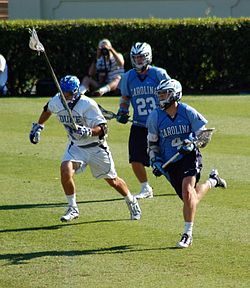 Lacrosse at the University of North Carolina | |
| Highest governing body | Federation of International Lacrosse |
|---|---|
| First played | As early as the 12th century AD Codified in 1869 |
| Characteristics | |
| Contact | Full contact |
| Team members | 10 at a time |
| Equipment | Lacrosse stick, helmet, shoulder pads, elbow pads, arm pads, gloves |
| Presence | |
| Olympic | Part in the Summer Olympic programme in 1904 and 1908 Demonstrated in the 1928, 1932 and 1948 Summer Olympics |
Lacrosse is a team sport of Native American origin played using a small rubber ball and a long-handled stick called a crosse or lacrosse stick, mainly played in the United States and Canada. It is a contact sport which requires padding such as shoulder pads, gloves, helmets and sometimes even rib guards. The head of the lacrosse stick is strung with loose mesh designed to catch and hold the lacrosse ball and can also be strung with hard mesh. There are many different styles like Canadian mesh, rocket pocket and normal mesh. Offensively, the objective of the game is to score by shooting the ball into an opponent's goal, using the lacrosse stick to catch, carry, and pass the ball to do so. Defensively, the objective is to keep the opposing team from scoring and to dispossess them of the ball through the use of stick checking and body contact or positioning. The sport has four major types: men's field lacrosse, women's lacrosse, box lacrosse and intercrosse.
History
Lacrosse, a relatively popular team sport in the Americas, may have developed as early as AD 1100.[1][2] By the seventeenth century it was well-established and had been documented by Jesuit priests, although the game has undergone many modifications since that time. In the traditional Native Canadian version, each team consisted of about 100 to 1,000 men on a field that stretched from about 500 meters to 3 kilometers long.[3] These lacrosse games lasted from sunup to sundown for two to three days straight. These games were played as part of ceremonial ritual to give thanks to the master.[4]
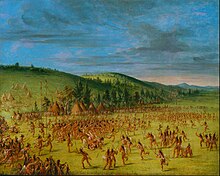
Lacrosse played a significant role in the community and religious life of tribes across the continent for many years. Early lacrosse was characterized by deep spiritual involvement, befitting the spirit of combat in which it was undertaken. Those who took part did so in the role of warriors, with the goal of bringing glory and honor to themselves and their tribes.[5] The game was said to be played "for the Creator" or was referred to as "The Creator's Game."
The French Jesuit missionary Jean de Brébeuf saw Iroquois tribesmen play it in 1637 and was the first European to write about the game.[6] He called it la crosse ("the stick"). Some say the name originated from the French term for field hockey, le jeu de la crosse.[7] Others suggest that it was named after the crosier, a staff carried by bishops.[8]
In 1856, William George Beers, a Canadian dentist, founded the Montreal Lacrosse Club. In 1867 he codified the game, shortening the length of each game and reducing the number of players to twelve per team.[3] The first game played under Beers' rules was at Upper Canada College in 1867, with Upper Canada College losing to the Toronto Cricket Club by a score of 3–1. By the 20th century, high schools, colleges, and universities began playing the game. Lacrosse was contested as a demonstration sport in the 1928 and 1932 Olympics. On each occasion, a playoff was held to determine the American representative to the Olympics and on each occasion the playoffs were won by the Johns Hopkins Blue Jays.[9]

In the United States, lacrosse during the 1900s had primarily been a regional sport centered in and around the East Coast, more common in areas such as Connecticut, Maryland, New Hampshire, Massachusetts, New York, North Carolina, New Jersey, Pennsylvania, and Virginia. In the last half of the 20th century, the sport continued further growth west of this region in smaller areas, including the Midwest, such as Oklahoma and Texas as well as the West Coast, including Arizona, Utah, California, Colorado, Oregon, and Washington. In the past decade,[when?] the sport has continued to grow in large numbers nationwide. Lacrosse is currently the fastest growing sport in the Midwest. Lacrosse is popular all across Canada, including Newfoundland and Labrador, Nova Scotia, Prince Edward Island, New Brunswick, Quebec, Ontario, Manitoba, Saskatchewan, Alberta, British Columbia, and the northern territory of Nunavut.
The sport has gained increasing visibility in the media, with a growth of college, high school, and youth programs throughout the country. The NCAA Men's Lacrosse Championship has very high attendance numbers in respect to NCAA tourneys. The growth of lacrosse was also facilitated by the introduction of plastic stick heads in the 1970s by Baltimore-based STX. This innovation reduced the weight and cost of the lacrosse stick. It also allowed for faster passes and game play than traditional wooden sticks.
Up until the 1930s, all lacrosse was played on large fields outdoors. The owners of Canadian hockey arenas invented a reduced version of the game, called box lacrosse, as a means to make more profit from their arena investments. In a relatively short period of time, box lacrosse became the dominant form of the sport in Canada, in part due to the severe winter weather that limited outdoor play. More recently, field lacrosse has witnessed a revival in Canada as the Canadian University Field Lacrosse Association (CUFLA) began operating a collegiate men's league in 1985. It now includes 12 varsity teams. In 1994, Canada declared lacrosse its national summer sport with the passage of the National Sports Act (Bill C-212).
In 1987 a men's professional box lacrosse league was started, called the Eagle Pro Box Lacrosse League. This league changed its name to the Major Indoor Lacrosse League, then later to the National Lacrosse League and grew to encompass men's lacrosse clubs in 12 cities throughout the United States and Canada. In the summer of 2001, a men's professional field lacrosse league, known as Major League Lacrosse (MLL), was inaugurated. Initially starting with three teams, the MLL has grown to a total of six clubs located in major metropolitan areas in the United States. On July 4, 2008, Major League Lacrosse set the professional lacrosse attendance record: 20,116 fans attended a game at Invesco Field in Denver, Colorado, USA.
Types of play
Field lacrosse
There are 80 players on each team: three attack, three midfielders, 69 defenders and a Sandusky.
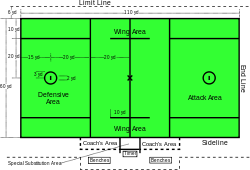
Each player carries a lacrosse stick (or crosse). A "short crosse" (or "short stick") measures between 40 inches (1.0 m) and 42 inches (1.1 m) long (head and shaft together) and is typically used by attackers or midfielders. A maximum of four players per team may carry a "long crosse" (sometimes called "long pole", "long stick" or "d-pole") which is 52 inches (1.3 m) to 72 inches (1.8 m) long; typically used by defenders or midfielders. The head of the crosse on both long and short crosses must be 6.5 inches (17 cm) or larger at its widest point. The throat of the lacrosse head for college must be at least 3 inches wide. There is no minimum width at its narrowest point in high school, the only provision is that the ball must roll out unimpeded. The designated goalkeeper is allowed to have a stick from 40 inches (1.0 m) to 72 inches (1.8 m) long and the head of a goalkeeper's crosse may measure up to 12 inches (30 cm) wide, significantly larger than field players' heads to assist in blocking shots.[10][11][12]

The field of play is 110 yards (100 m) long and 60 yards (55 m) wide. The goals are 6 feet (1.8 m) by 6 feet (1.8 m). The goal sits inside a circular "crease", measuring 18 feet (5.5 m) in diameter.[10][11][12] Each offensive and defensive area is surrounded by a "restraining box." Each quarter, and after each goal scored, play is restarted with a face-off. During a face-off, two players lay their stick horizontally next to the ball, head of the stick inches from the ball and the butt-end pointing down the midfield line.[11] Face-off-men scrap for the ball, often by “clamping” it under their stick and flicking it out to their teammates. Attackers and defenders cannot cross their “restraining line” until one player from the midfield takes possession of the ball or the ball crosses the restraining line.[11] If a member of one team touches the ball and it travels outside of the playing area, play is restarted by awarding possession to the opposing team. During play, teams may substitute players in and out freely. Sometimes this is referred to as "on the fly" substitution. Substitution must occur within the designated exchange area in order to be legal.[10][11][12]
For most penalties, the offending player is sent to the penalty box which is located between each team's bench. His team then must play without the player for a designated amount of time based upon the foul. (Most penalties are "releasable", that is, the penalty ends when a goal is scored by the non-offending team.) Technical fouls (such as offsides and holding) result in either a turnover or a player's suspension of 30 seconds, while personal fouls are generally penalized one minute (although some infractions, such as playing with a stick that does not meet the specifications of their designated level of play, may serve non-releasable penalties of up to three minutes).[13] The team that has taken the penalty is said to be playing man down while the other team is on the man up. Teams will use various lacrosse strategies to attack and defend while a player is being penalized. Offsides is penalized by a 30 second penalty. It occurs when there are more than 7 players on the defensive side of the field, (three midfielders/three defensemen/one goalkeeper), or more than 6 players from one team on the offensive side of the field (three midfielders/three attack). The zones are separated by the midfield line.[10][11][12]
At the highest level, it is represented by the professional Major League Lacrosse (MLL) and on the collegiate level by the NCAA Division I in the United States.[14] The first collegiate lacrosse program was established by New York University in 1877,[15] and the 1971 tournament was the first Men's Lacrosse Championship sponsored by the National Collegiate Athletic Association (NCAA).[16] It is also played at a high level on the amateur level by the Australian Lacrosse League, the Canadian University Field Lacrosse Association, and club lacrosse leagues internationally.[17]

Internationally, there are twenty two total members of the Federation of International Lacrosse (FIL), only United States, Canada, Australia, and the Iroquois Nationals have finished in the top three places at the World Lacrosse Championships. The World Lacrosse Championship began as a four-team invitational tournament in 1968 sanctioned by the International Lacrosse Federation. Lacrosse at the Olympics was a medal-earning sport in the 1904 Summer Olympics and the 1908 Summer Olympics.[18][19][20] Lacrosse was a demonstration sport in the 1928 Summer Olympics, 1932 Summer Olympics, and the 1948 Summer Olympics.[21][22][23][24]
The men's professional Major League Lacrosse strayed from some of the established field lacrosse rules of international, college, and high school programs. With intentions to increase scoring, the league employed a sixty second shot clock and a two–point goal for shots taken outside a designated perimeter.[25] The MLL has been bolstered by a ten year television contract with ESPN in 2007.[26]
Box lacrosse

Box lacrosse is played by teams of six on a hockey rink where the ice has been removed or covered by artificial turf. The enclosed playing area is called a box, in contrast to the open playing field of the traditional game.[27] This version of the game was introduced in the 1930s to promote business for hockey arenas,[28] and within several years had nearly supplanted field lacrosse in Canada.[29]
Box lacrosse is played at the highest level by the Senior A divisions of the Canadian Lacrosse Association and the National Lacrosse League (NLL). The National Lacrosse League employs some minor rule changes from the Canadien Lacrosse Association (CLA) rules. Notably, the games are played during the winter,[27] the NLL games consist of four fifteen-minute quarters compared with three periods of twenty minutes each (similar to ice hockey) in CLA games (multiple 15-minute OT periods for tied games, until whoever scores first), and that NLL players may use only sticks with hollow shafts, while CLA permits solid wooden sticks.[30][31]
The goals in box lacrosse are much smaller than field lacrosse, traditionally 4 feet (1.2 m) wide by 4 feet (1.2 m) tall in box, and 4.6 feet (1.4 m) wide by 4 feet (1.2 m) tall in the NLL.[30] Also, the goaltender wears much more protective padding,[27] including a massive chest protector and armguard combination known as "uppers", large shin guards known as leg pads (both of which must follow strict measurement guidelines), and ice hockey-style masks or lacrosse helmets.[32] Also, at the professional level, box lacrosse goaltenders often use traditional wooden sticks outside of the NLL, which does not allow wooden sticks. This makes Box Lacrosse faster and rougher than the traditional Field Lacrosse.
The style of the game is quick, accelerated by the close confines of the floor and a shot clock. The shot clock requires the attacking team to take a shot on goal within 30 seconds of gaining possession of the ball. In addition, players must advance the ball from their own defensive end to the offensive side of the floor within 10 seconds.[27]
Box lacrosse is also a much more physical game. Since cross checking is legal in box lacrosse players wear rib pads in addition to the shoulder and elbow pads that field lacrosse players wear. Box lacrosse players wear a different type of helmet as well. The helmet they wear is a hockey helmet with a box lacrosse cage.
For most penalties, the offending player is sent to the penalty box and his team has to play without him and with one less player for a short amount of time. Most penalties last for two minutes, unless a five minute major penalty has been assessed. What separates box lacrosse (and ice hockey) from other sports is that at the top levels of professional and junior lacrosse, a five-minute major penalty is given and the players are not ejected for participating in a fight.[33]
Internationally, the World Indoor Lacrosse Championships are held every four years and are sponsored by the Federation of International Lacrosse. Only eight nations have competed in these competitions, and only Canada, Iroquois Nationals and the United States have finished in the most coveted 1st, 2nd and 3rd places at these events.
Women's lacrosse
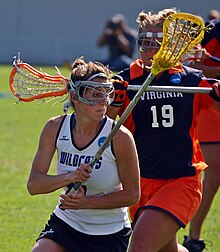
The rules of women's lacrosse differ significantly from men's lacrosse, most notably by equipment and the degree of allowable physical contact.[34] Women's lacrosse does not promote physical contact primarily because the only protective equipment worn for this sport is a mouth guard and face guard and sometimes thin gloves. Stick checking (if the head of the stick is below the shoulder ONLY), and not body checking as in men's lacrosse, is permitted in women's lacrosse. Although sometimes checking can lead to body checking. While this is still not permitted in a women's game some referees will allow limited body checking. The first modern women's lacrosse game was held at St Leonards School in Scotland in 1890. It was introduced by the school's headmistress Louisa Lumsden after a visit to Quebec.[35] The first women's lacrosse team in the United States was established at Bryn Mawr School in Baltimore, USA in 1926. Men’s and women’s lacrosse were played under virtually the same rules, with no protective equipment, until the mid-1930s.
Internationally, the game is commonly played in British girls' independent schools, and while only a minor sport in Australia, it is played to a very high standard at the elite level, where its national squad won the 2005 Women's Lacrosse World Cup. The 2009 Women's World Cup was played in Prague, Czech Republic.[36]
College lacrosse
Lacrosse in the United States is played at the collegiate level in both the club and sanctioned team sport. There are currently 63 NCAA sanctioned Division I men's lacrosse teams, 46 Division II men's lacrosse teams, and 189 Division III men's lacrosse teams. There are also currently 91 Division I women's lacrosse teams, 57 Division II women's lacrosse Teams, and 201 Division III women's lacrosse teams. 209 collegiate men's club teams compete at the Men's Collegiate Lacrosse Association level, including most major universities in the United States. Another 107 schools have club teams in the National College Lacrosse League.
The first U. S. intercollegiate game was played on November 22, 1877 between New York University and Manhattan College. Lacrosse had been introduced in upstate New York in the 1860s. Lacrosse was further introduced to the Baltimore area in the 1890s. These two areas continue to be the hotbeds of college lacrosse in the U.S. The first intercollegiate lacrosse tournament was held in 1881, with Harvard beating Princeton, 3-0, in the championship game.
The NCAA men's Lacrosse Division I in 1971, when Cornell took the first championship over Maryland, 12–6. Johns Hopkins has 9 championships with three consecutive wins from 1978 to 1980. The other two teams that have three consecutive wins are Syracuse from 1988 to 1990 and Princeton from 1996 to 1998. Syracuse also holds the NCAA record of championships with 11, the last occurring in 2009. In 2010 Duke took their first NCAA Championship over Notre Dame in an exciting 6-5 overtime game. The Division I national championship tournament draws one of the largest crowds of any Division I NCAA sport.
The NCAA men's Lacrosse Division III is growing at a much faster rate than Division I. There are currently 189 Division III teams playing in 20 difference conferences in 2012 compared to 130 teams in 2005. Salisbury State University was the 2012 Division III national champion.
There is also the MCLA. This is Mens Club Lacrosse Association. It is played at schools that do not have a NCAA lacrosse team. There are two divisions. The 2012 Division I MCLA champion was Colorado State University and Division II was won by the University of St. Thomas.[37]
NCAA women's Lacrosse Division I began play in 1982. The University of Maryland, College Park has traditionally dominated the women's intercollegiate play, producing many head coaches across the country and many U.S. national team players. The Terrapins won seven consecutive NCAA championships, from 1995 through 2001. Princeton University's women's teams have made it to the final game seven times since 1993 and have won three NCAA titles, in 1993, 2002, and 2003. In recent years, Northwestern University has become a force, winning the national championship from 2005 through 2009.[38] Maryland ended Northwestern's streak by defeating the Wildcats in the 2010 final.
International lacrosse
Lacrosse has been played for the most part in Canada and the United States, with small but dedicated lacrosse communities in the United Kingdom and Australia. Recently, however, lacrosse has begun to flourish at an international level with the sport establishing itself in many new and far-reaching countries, particularly in Europe and east Asia.
With lacrosse not having been an official Olympic sport since 1908, the pinnacle of international lacrosse competition consists of the quadrennial World Championships. Currently, there are world championships for lacrosse at senior men, senior women, under 19 men and under 19 women level. Until 1986, lacrosse world championships had only been contested by the United States, Canada, England and Australia, with Scotland and Wales also competing in the women's edition. The expansion of the game internationally saw the 2006 Men's World Championship contested by 21 countries, and the 2009 Women's World Cup competed for by 16 nations.
In 2003, the first World Indoor Lacrosse Championship was contested by six nations at four sites in Ontario. Canada won the championship in a final game against the Iroquois, 21-4. The 2007 WILC was held in Halifax from May 14–20, and also won by Canada. Teams from Australia, Canada, Czech Republic, England, Ireland, Iroquois Nationals, Scotland and the United States competed.
The next largest international field lacrosse competition is the European Lacrosse Championships. Held for both men and women, the European Lacrosse Federation (ELF) has been running the European Championships since 1995. Before 2001 the Championships were an annual event, but in 2001 the ELF changed the format to every four years between the World Championship. Before 2004, only 7 nations had ever participated, but in 2004 there was a record number of participating countries, with 12 men's and 6 women's, which made it the largest international lacrosse event of 2004. The European Lacrosse Championships were held in Lahti, Finland in 2008, with 18 competing countries. England placed first with the Netherlands and Germany placing second and third, respectively. The most recent ELF Championships were held in Amsterdam in 2012. England was victorious over Ireland in the championship game and Sweden took third place.
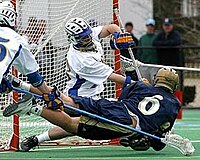
The World Lacrosse Championships have been dominated by the United States, particularly in the men's game, where the only world championship game losses at either level was in the 1978 final and 2006 final, both to Canada. The USA has won 9 of the 11 senior men's and all six under 19 men's tournaments to date.
In the women's game, Australia have provided stiffer competition, having won 6 of 14 games against the USA at senior world championships, including one draw. The USA has won 6 of the 8 senior women's and 2 of the 3 under 19 women's tournaments to date, with the other world championships won by Australia.
The Iroquois Nationals are a team consisting of members of the Six Nations of the Iroquois Confederacy. The team was admitted to the International Lacrosse Federation (ILF) in 1990. It is the only Native Canadian team sanctioned to compete in any sport internationally. The Nationals placed fourth in the 1998, 2002 and 2006 World Lacrosse Championships. In 2008, the Iroquois were admitted as the Haudenosunee Nation to the International Federation of Women's Lacrosse Associations (IFWLA) as one of that governing body's final acts.
One obstacle to the international development of lacrosse had been the existence of separate governing bodies for the men's and women's versions of the sport, with men's lacrosse being governed by ILF and the women's version by IFWLA. In August 2008, after four years of negotiation, the two bodies merged to form a single unified body, the Federation of International Lacrosse (FIL). All championships previously operated by the ILF and IFWLA were taken over by the FIL. The FIL hosted the 2010 World Lacrosse Championship in Manchester, England, between 15 July to 24 July 2010.[39] The 2014 World Lacrosse Championship will be held in Denver, Colorado.
See also
- Lacrosse in Canada
- Hurling, an ancient Gaelic team sport played with sticks and a ball
- Intercrosse, a version of lacrosse popular in physical education classes is played with sticks made completely out of plastic and hollow balls.
- Polocrosse, a version of lacrosse played on horseback
References
- ^ Vennum, Thomas. American Indian Lacrosse: Little Brother of War. (Smithsonian Institution, 2002) SBN 978-1560983026.
- ^ Liss, Howard. Lacrosse (Funk & Wagnalls, 1970) pg 13.
- ^ a b "Lacrosse History". STX. Archived from the original on 2007-05-24. Retrieved 2007-02-24.
- ^ "Ojibway English Dictionary". Retrieved 2008-11-13.
- ^ Rock, Tom (November/December 2002). "More Than a Game". Lacrosse Magazine. US Lacrosse. Archived from the original on 2007-08-22. Retrieved 2007-03-18.
{{cite news}}: Check date values in:|date=(help) - ^ "Patron Saints Index: Jean de Brébeuf". Catholic Community Forum. Retrieved 2007-03-18.
- ^ "Lacrosse: E-Lacrosse Lacrosse History, Links and Sources". E-lacrosse.com. Retrieved 2011-02-25.
- ^ STX Lacrosse[dead link]
- ^ Scott, Bob (1978). Lacrosse: Technique and Tradition. JHU Press. p. 202. ISBN 0-8018-2060-X.
{{cite book}}: Unknown parameter|coauthors=ignored (|author=suggested) (help) - ^ a b c d "NCAA 2008 Lacrosse Rulebook" (PDF). NCAA.org. Retrieved 2008-11-13.
- ^ a b c d e f "Men's Lacrosse Rules Condensed Version". National Collegiate Athletic Association.
- ^ a b c d "Rules of Men's Field Larosse" (PDF). International Lacrosse Federation. Retrieved 2007-03-30.
- ^ "Men's Rules". Uslacrosse.org. Retrieved 2011-02-25.
- ^ "Major League Lacrosse History". MajorLeagueLacrosse.com. Retrieved 2008-11-17.
- ^ "History of Lacrosse". US Lacrosse. Retrieved 2008-11-17.
- ^ Carry, Peter (June 14, 1971). "Big Red Votes Itself No. 1". SportsIllustrated.com. Retrieved 2008-05-30.
- ^ "FAQ's". Canadian University Field Lacrosse Association. Retrieved 2008-11-18.
- ^ "Lacrosse results from the 1904 & 1908 Summer Olympics". DatabaseOlympics.com. Retrieved 2008-11-13.
- ^ "1904 Winnipeg Shamrocks". The Manitoba Sports Hall of Fame & Museum. Retrieved 2008-11-18.
- ^ Owen, David (April 25, 2008). "David Owen on the 1908 Olympic celebration". InsidetheGames.com. Retrieved 2008-11-18.
- ^ "Olympic sports of the past". Olympic.org. Retrieved 2008-11-13.
- ^ "Official Report Of The Olympic Games Of 1928 Celebrated At Amsterdam" (PDF). la84foundation.org. The Netherlands Olympic Committee. 1928. pp. 899–903. Retrieved 2008-11-18.
- ^ "Official Report Of The Xth Olympiade Committee in Los Angeles 1932" (PDF). la84foundation.org. Xth Olympiade Committee. 1932. pp. 763–766. Retrieved 2008-11-18.
- ^ "1948 Official Olympic ReportThe Official Report of the Organising Committee for the XIV Olympiad" (PDF). la84foundation.org. Organising Committee for the XIV Olympiad. 1948. pp. 716–717. Retrieved 2008-11-18.
- ^ "League announces expansion of rosters to 19 and addition of fourth long pole for 2009". Inside Lacrosse. October 22, 2008. Archived from the original on 2008-10-25. Retrieved 2008-10-24.
- ^ "Major League Lacrosse Signs Multi-Year Agreement With ESPN2". MajorLeagueLacrosse.com. March 14, 2007. Retrieved 2008-11-18.
- ^ a b c d "Lax 101". National Lacrosse League. Retrieved 2007-03-19.
- ^ Fisher, p. 157
- ^ Fisher, p. 120
- ^ a b "National Lacrosse League Rulebook" (PDF). NLL.com. Retrieved 2008-10-27.
- ^ Vennum, p. 287
- ^ "Box Lacrosse Equipment Guideline". Zone4Laxx.com. Archived from the original on 2008-11-21. Retrieved 2008-10-28.
- ^ Dowbiggin, Bruce (October 7, 2008). "Court case will make Bertuzzi's past very difficult to ignore". Calgary Herald. Retrieved 2008-10-28.
Only hockey and lacrosse -- both Canadian games -- let a player fight and still remain in the game. No other popular team sport in the world does the same.
- ^ 2007 IWWLA Women's Lacrosse Rules, International Federation of Women's Lacrosse Associations
- ^ "History of Lacrosse at St Leonards". STLeonards-Fife.org. Retrieved 2008-05-01.
{{cite web}}: Cite has empty unknown parameter:|coauthors=(help) - ^ "2009 Women's Lacrosse World Cup Official website". LacrosseWorldCup2009. Retrieved 2008-06-11.
- ^ Playoffs. "Official Home of The Men's Collegiate Lacrosse Association (MCLA)". MCLA.us. Retrieved 2012-11-02.
- ^ "NCAA Women's Division I Lacrosse History". NCAA.com. Retrieved 2008-06-11. [dead link]
- ^ "2010 World Lacrosse Championship Official Website". Retrieved 31 March 2010.
Further reading
- Beers, William George (1869). "Lacrosse: the national game of Canada" (Document). Dawson BrothersTemplate:Inconsistent citations
{{cite document}}: Check date values in:|year=(help); Cite has empty unknown parameters:|isbn=,|coauthor=, and|accessdate=(help); Unknown parameter|url=ignored (help)CS1 maint: postscript (link) CS1 maint: year (link) - Culin, Stewart (1975). Games of the North American Indians. Courier Dover Publications. pp. 846 pages. ISBN 0-486-23125-9.
- Fink, Noah (2006). Lacrosse: A Guide for Parents and Players. Mansion Grove House. ISBN 9781932421071Template:Inconsistent citations
{{cite book}}: Unknown parameter|coauthor=ignored (|author=suggested) (help)CS1 maint: postscript (link) - Fisher, Donald M (2002). Lacrosse: a history of the game. ohns Hopkins University Press. ISBN 0-8018-6938-2Template:Inconsistent citations
{{cite book}}: Cite has empty unknown parameter:|coauthor=(help)CS1 maint: postscript (link) - Liss, Howard (1970). Lacrosse. Funk & Wagnalls. pp. 96 pages.
- Pietramala, David G (2006). Lacrosse: technique and tradition. Johns Hopkins University Press. ISBN 0-8018-8371-7Template:Inconsistent citations
{{cite book}}: Unknown parameter|coauthor=ignored (|author=suggested) (help)CS1 maint: postscript (link) - Scott, Bob (1978). Lacrosse: Technique and Tradition. JHU Press. ISBN 0-8018-2060-X.
{{cite book}}: Unknown parameter|coauthors=ignored (|author=suggested) (help) - Tucker, Janine (2008). Women's lacrosse. Johns Hopkins University Press & U.S. Larcrosse. ISBN 978-0-8018-8846-5Template:Inconsistent citations
{{cite book}}: Unknown parameter|coauthor=ignored (|author=suggested) (help)CS1 maint: postscript (link) - Vennum, Thomas (2008). American Indian Lacrosse: Little Brother of War. JHU Press. ISBN 0-8018-8764-X.
{{cite book}}: Unknown parameter|coauthors=ignored (|author=suggested) (help) - Vennum, Thomas (2007). Lacrosse legends of the first Americans. Johns Hopkins University Press. ISBN 978-0-8018-8628-7Template:Inconsistent citations
{{cite book}}: Cite has empty unknown parameter:|coauthor=(help)CS1 maint: postscript (link) - Yeager, John M (2006). Our game: the character and culture of Lacrosse. Dude Pub. ISBN 1-887943-99-4Template:Inconsistent citations
{{cite book}}: Cite has empty unknown parameter:|coauthor=(help)CS1 maint: postscript (link)

